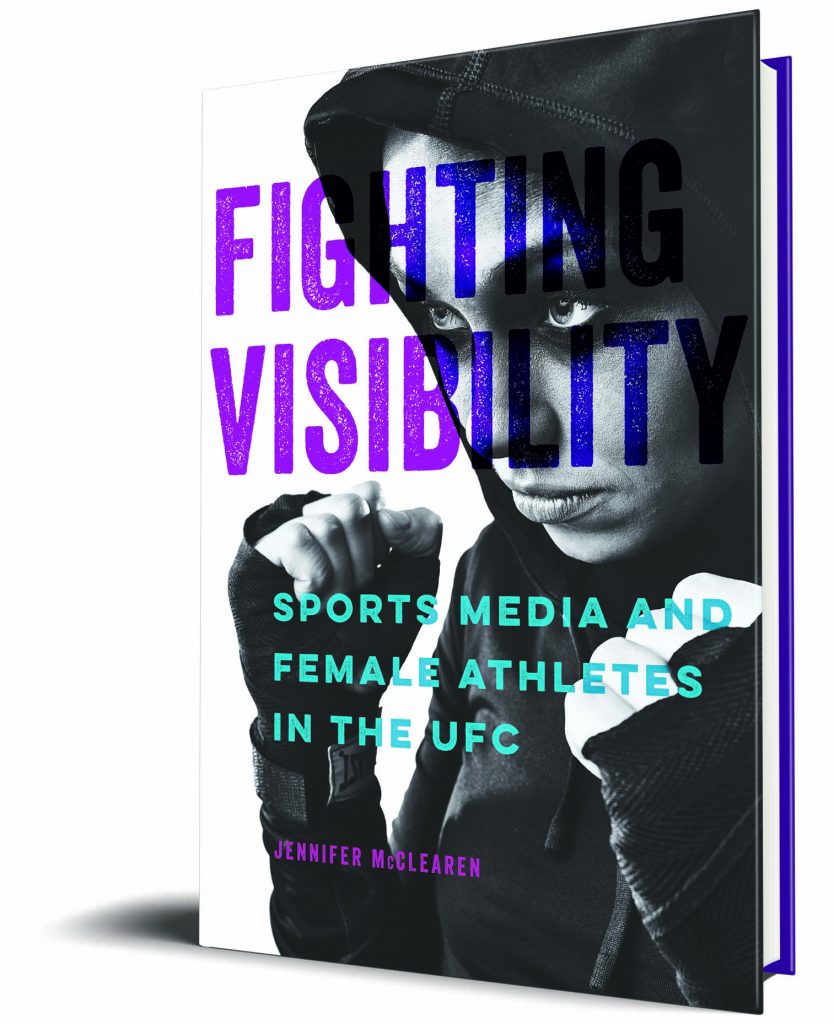We recently chatted with author Jennifer McClearen about her new book, Fighting Visibility: Sports Media and Female Athletes in the UFC.
Q: Why did you decide to write this book?
Fighting Visibility began as a mild curiosity when I started watching the Ultimate Fighting Championship (UFC) with a group of my Brazilian Jiu Jitsu training partners in 2012. I had been aware of mixed martial arts (MMA) and the UFC for several years, but generally accepted the stereotype that the promotion peddled unbridled violence that served as entertainment by and for meatheads. I never thought that a sport that U.S. senator John McCain once called “human cockfighting” might be something I would watch let alone end up writing a book about. But my perception of the UFC began to change around the time that they decided to sign Ronda Rousey as their first female fighter.
I skeptically watched the UFC market their first women’s MMA match in 2013 between Rousey and Liz Carmouche and fully expected the promotion to resort to sexualizing or trivializing female athletes with little fanfare because that’s how sports media often treats female athletes. To my surprise, the UFC began marketing its female athletes as empowered heroines breaking boundaries in their sport and seeking the American dream. Carmouche was an out lesbian and former marine who didn’t fit the heterosexy athlete pin-up that usually sells. Rousey soon became the UFC’s highest paid athlete and the face of the UFC for mainstream audiences. So, the book began with a simple question: how did a hypermasculine brand built upon a reputation of no-holds-barred fighting get in the business of women’s empowerment?
Q: Who were your biggest influences?
The theoretical heart of this book relies heavily on the work of feminist and critical/cultural scholars who critique what representations of diverse identities actually do to improve inequities in society. The scholars that I use in my work include Herman Gray, Sarah-Banet Weiser, Kristen Warner, and Ralina Joseph. Reading Gray’s article Subject(ed) to Recognition and Banet-Weiser’s books Authentic and Empowered propelled my thinking about representation early in the writing of this book. In much of media culture, we see a proliferation of images of diverse identities that get folded into neoliberal market logics that can be profitable for brands by circulating a great deal of cultural cache, which is what Gray and Banet-Weiser illuminate in particular. Kristen Warner’s short article Plastic Representation and Mary Beltrán’s Flow Journal piece on Meaningful Diversity are also ideas that I put in conversation in this book.

Q: What is the most interesting discovery you made while researching and writing your book?
I had no intention of writing about labor when I first began Fighting Visibility. Yet, as I dug into the research, it became crystal clear that just because a sports media organization depicts female athletes as empowered symbols, doesn’t mean that they have agency in their work. In fact, they may be severely disenfranchised workers. UFC fighters are independent contractors, which means they don’t have year-round health insurance, retirement benefits, or guaranteed income. In a profession where you literally put your body on the line, this is highly problematic considering that most fighters are underpaid, and the UFC is worth billions. Fighters cannot break their contracts, but the UFC can at whim, which makes fighters extremely nervous about their job status. The book explores how the UFC capitalizes on diverse female athletes while exploiting the labor of those same athlete-workers. The most disenfranchised are often women of color, lesbians, or gender non-conforming women.
Q: What myths do you hope your book will dispel or what do you hope your book will help readers unlearn?
I want to burst the mirage in progressive sports discourse that representation mattering is unilaterally beneficial to women athletes. I urge those already invested in women’s sports, such as scholars, activists, journalists, and fans, to critically examine what we assume are representational victories in the sporting arena. “Positive” or even “meaningful and accurate” representations of female athletes are co-opted by corporate interests that can actually disenfranchise women even as they become more visible than ever before. The UFC is at the forefront of monetizing female athletes in ways that emphasize their difference and make it sellable even though most women’s sports have lagged behind the trends that Gray, Banet-Weiser, and Warner describe in their work.
Q: What is the most important idea you hope readers will take away from your book?
As I write in the book, “Instead of asking ‘are women present in the UFC’ or ‘are these representations fair,’ I take a cue from Donna Haraway (1997) to ask ‘How is visibility possible? For whom, by whom, and of whom? What remains invisible, to whom, and why?’ (202).” The book argues that the UFC’s promotion of diverse female athletes actually serves as a seductive mirage of progress that enables the brand’s exploitative labor practices. We must constantly ask the question “who benefits” from these representations because visibility in itself doesn’t grant marginalized people as much power as we once might have assumed. The UFC’s labor model disproportionately taxes female athletes, particularly women of color and gender non-normative women, despite also promoting them at unprecedented levels. The book complicates a prevalent cultural notion that the increased visibility of female athletes will lead to greater equity in sports media and instead urges us to question who is harmed by neoliberal business practices.
Q: What do you like to read/watch/or listen to for fun?
My favorite show right now is Warrior (Justin Lin and Jonathan Tropper), which is a martial arts period drama/action show about Chinese immigrants in San Francisco in the 1870s during the decline of the gold rush. The cast is predominantly of Asian descent and the creators do a fantastic job of creating rich and relatable characters. The women are even well-written, which is atypical of this genre. The show deftly depicts the historical anti-Chinese racism of the era while being certain to illustrate these connections with contemporary anti-Asian rhetoric. You can feel the weight of oppression on the characters, but they push back through martial arts in ways that feel very cathartic, in ways that Blaxploitation films were also able to do. On top of all this, the martial arts sequences are some of the most beautifully choreographed fight scenes I’ve seen in film or television. The show was inspired by the writings of Bruce Lee and his daughter, Shannon Lee, is one of the producers. I’m obviously a huge fan of Warrior and I hope the show gets picked up somewhere for a third season.
Make sure to also check out the recording of the book launch for Fighting Visibility, featuring the author in conversation with Julie Kedzie!

